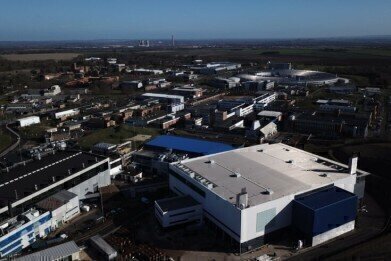-
 Rutherford Appleton Laboratory Credit: STFC
Rutherford Appleton Laboratory Credit: STFC -
 Professor Andrew Harrison Credit: Diamond Light Source
Professor Andrew Harrison Credit: Diamond Light Source
News & Views
Looking towards the UK's Future Light Sources - How will these be improved?
Jun 23 2021
Support from the UKRI Infrastructure fund will see two globally renowned Oxfordshire research facilities set the groundwork needed to advance next generation neutron and X-ray science technologies.
Scientists at the Science and Technology Facilities Council’s (STFC) Rutherford Appleton Laboratory (RAL) will use the £4 million outlined to plan the successors to the current world-class ISIS Neutron and Muon Source and Diamond Light Source at RAL, enabling scientists to continue answering the key scientific questions of the day with enhanced imaging techniques and applications.
Researchers at RAL, located on the Harwell campus undertake pioneering work to address some of the important challenges facing society, in areas such as:
- particle physics
- scientific computing
- laser development
- space research
- technology.
Top facilities in a cluster
Professor Mark Thomson, Chief Executive of STFC, said: “STFC’s RAL campus is the home to a variety of very large multi-disciplinary research facilities, including the Diamond Light Source synchrotron and the ISIS Neutron and Muon Source. RAL is unique in bringing together such a wide range of top-end facilities on a single site.”
“These world-leading machines provide intense beams of light and other particles to image matter at the molecular and atomic scale for a wide range of research disciplines. The investment announced today (June 21) is an important step in maintaining the UK’s position as a global science leader with cutting-edge national scientific facilities.”
ISIS-II
A £1.5 million investment will enable STFC to look into a successor for the ISIS Neutron and Muon Source facility, which will be needed by 2040. The facility produces beams of neutrons and muons enabling study of materials at the atomic level using a suite of instruments, often described as ‘super-microscopes’.
As a unique tool for exploring materials at the nanoscale in a non-destructive way, neutron imaging can be used in a range of applications, which include:
- the properties of paint in valuable artwork
- the structure of ancient artefacts and archaeological finds
- the structure of cells and how they interact with drug
The proton accelerator at the heart of ISIS creates intense pulses of protons at 84% the speed of light, 50 times a second, aimed at target stations where they are used to generate neutrons in a process known as spallation
This scoping project will enable research into an optimal accelerator and target system architecture for ISIS-II.
Professor Robert McGreevy, Director of the ISIS Facility, said: “For over 30 years ISIS has been a world renowned UK research facility, used to study everything from anti-bacterials to batteries. But the present facility won’t last forever. This investment enables us to start the early design for a new facility.”
Diamond-II
Diamond Light Source is the UK’s national synchrotron, based at RAL and funded via STFC and the Wellcome Trust. It harnesses the power of electrons to produce incredibly intense beams of X-ray light that can be used like a giant microscope to image matter at the molecular and atomic scale.
This latest £2.5 million investment will support the first phase of developing the final technical design for a transformative upgrade of the light source.
Known as Diamond-II, the upgrade plans include:
- replacing the existing electron storage ring at the heart of Diamond
- new and upgraded beamlines
- a supporting data infrastructure.
Improving Light Performance
This programme will offer a 70-fold improvement in the brightness of the light, increasing performance through:
- the speed of its observations
- resolution of images
- sensitivity of chemical analysis.
This will open up wholly new insights into materials research, as well as offering:
- a faster method for materials discovery or drug development
- real-time insights into processes such as advanced manufacturing and the performance of operating devices (next-generation batteries).
Professor Andrew Harrison, CEO Diamond Light Source, said: "Diamond’s mission is to keep the UK at the forefront of scientific research. We do this by providing our 14,000 strong users in academia and industry with access to our state-of-the-art facilities, enabling them to fulfil their research goals across a wide variety of scientific disciplines.
"The economic impact of Diamond has been estimated as at least £1.8 billion to date, representing a very favourable return on investment. The Diamond-II Programme will build-on Diamond’s world-class position and enable us to continue to deliver brilliant science tackling some of the most challenging scientific questions of the 21st century.
"We are very grateful to our funding agencies UKRI’s STFC and the Wellcome Trust for their trust and ongoing support.”
More information on RAL online
More information on ISIS Neutron and Muon source online
More information on Diamond Light source online
Digital Edition
Lab Asia 31.2 April 2024
April 2024
In This Edition Chromatography Articles - Approaches to troubleshooting an SPE method for the analysis of oligonucleotides (pt i) - High-precision liquid flow processes demand full fluidic c...
View all digital editions
Events
Apr 28 2024 Montreal, Quebec, Canada
May 05 2024 Seville, Spain
InformEx Zone at CPhl North America
May 07 2024 Pennsylvania, PA, USA
May 14 2024 Oklahoma City, OK, USA
May 15 2024 Birmingham, UK

















